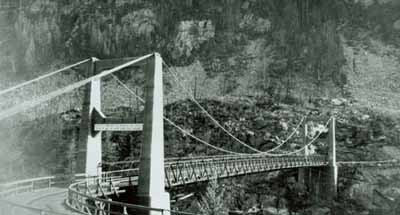Doukhobor Suspension Bridge National Historic Site of Canada
Castlegar, British Columbia

General view
(© Agence Parcs Canada/Parks Canada Agency, 1994.)
Address :
near Highway 3A, Castlegar, British Columbia
Recognition Statute:
Historic Sites and Monuments Act (R.S.C., 1985, c. H-4)
Designation Date:
1995-07-06
Dates:
-
1913 to 1913
(Construction)
-
1913 to 1916
(Significant)
Event, Person, Organization:
-
Doukhobor community, Brilliant
(Organization)
-
J.R. Grant & A.M. Truesdale
(Architect)
-
Cartwright, Matheson & Co.
(Architect)
Other Name(s):
-
Doukhobor Suspension Bridge
(Designation Name)
-
Brilliant Suspension Bridge
(Other Name)
Research Report Number:
1995-001, 2007-CED-SDC-04
Plaque(s)
Existing plaque: Castlegar, British Columbia
This historic bridge commemorates an achievement of the Doukhobors of Canada in establishing communal settlements in the Kootenay Boundary region of British Columbia during the early 20th century. Built in 1913 by community labour, the bridge connected Doukhobor settlements on both sides of the Kootenay River, and served as a vital transportation link in the area for over fifty years. Today, this structure, also known as the Brilliant Suspension Bridge, stands as an enduring symbol of the collective toil of these Christian pacifist pioneers, and their contribution to Canada’s development.
Description of Historic Place
The Doukhobor Suspension Bridge spans the Kootenay River a short distance upstream from its confluence with the Columbia River in the West Kootenay region of British Columbia. Built as a community effort, the structure is comprised of reinforced concrete towers that rise to a height of 14.6 metres (48 feet) and rest on concrete piers embedded in the rock face on opposite banks of the river. The two towers support four steel wire cables that are attached at both ends to steel sockets anchored in the rock face. The bridge deck linking the towers is 100.9 metres (331 feet) in length and is suspended from the overhead cables by vertical steel rods. The deck frame is constructed of structural steel covered by wooden planks, stringers and surface decking. The wood decking is now badly deteriorated, and approach ramps to the bridge have been removed to prevent access. Official recognition refers to the bridge structure and its footings.
Heritage Value
The Doukhobor Suspension Bridge was designated a national historic site in 1995 because: it was built by, and is closely associated with, the Doukhobours who were engaged in a significant effort in the first half of the 20th century to build a Christian utopian community in western Canada; the bridge ranks as a symbol of Doukhobour culture and is one of the few remaining built resources connected with this cultural group in the period before the Second World War; and its construction almost entirely by Doukhobour settlers was a major accomplishment for a pioneer community and demonstrated the considerable capabilities of a people acting communally.
The Doukhobor Suspension Bridge provided a vital road link between the Doukhorbor communities of Brilliant and Ootenshenie on opposite sides of the Kootenay River. Its construction was undertaken by members of this utopian community who volunteered their labour at the behest of their leader, Peter Vasilevich Verigin. Using traditional hand labour techniques, the workers undertook the challenging tasks of forming and pouring the piers and towers in the recently introduced medium of reinforced concrete, then assembling and installing the massive cables and steel decking. Begun in April 1913 and completed just 8 months later, the Doukhobor Suspension Bridge was largely financed by the Doukhobor community and played an important role in the cultural and economic growth of this distinctive self-supporting communal society and of the West Kootenay region for over 50 years.
Source: Historic Sites and Monuments Board of Canada, Minutes, July 1995.
Character-Defining Elements
The key elements relating to the heritage value of this site include: the footprints of the concrete piers and towers and concrete anchorages sunk into the rock face on both sides of the river; sight lines of the bridge from both sides of the river; the form and massing of the concrete piers, towers and cross members; the steel wire cables, tower saddles and socket attachments; steel deck frame, railings, vertical hanger rods and stiffening trusses; the use of wood plank bridge decking; the date inscription on a concrete tower.